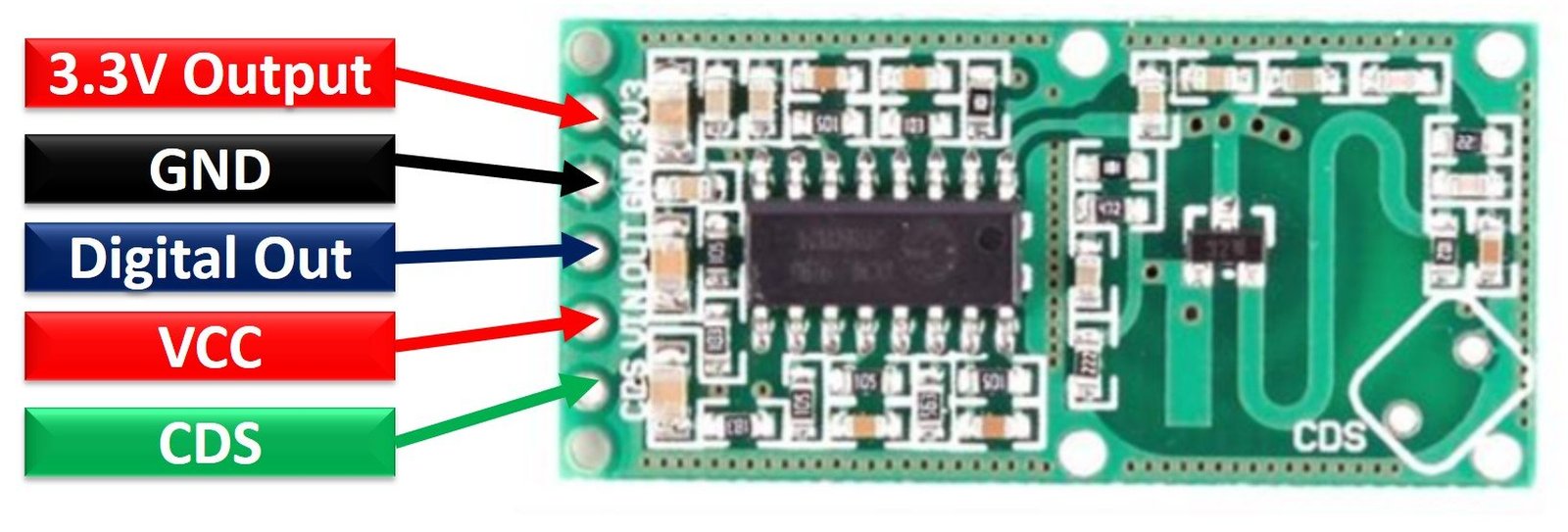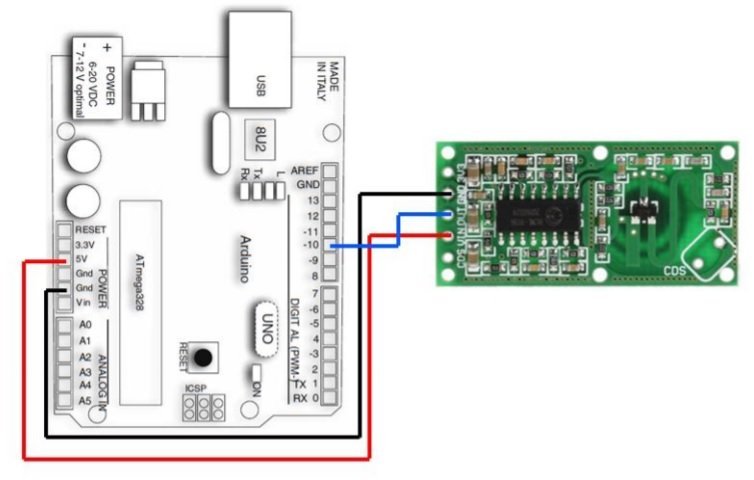AED 12.50
Description
The Microwave Doppler Radar Motion Sensor RCWL-0516 is a small and affordable sensor module that detects motion using microwave Doppler radar technology. It emits microwaves and detects the reflection of those microwaves off of moving objects to detect motion. The module is equipped with a built-in amplifier and filter circuitry to minimize false triggers and improve sensitivity. It can be easily connected to a microcontroller or other device and can operate on a wide range of input voltages. It is commonly used in various applications, such as security systems, lighting control, and home automation.
Package Includes:
- 1 x Microwave Doppler Radar Motion Sensor RCWL-0516
Features:
- Uses microwave Doppler radar technology to detect motion
- Output pin goes HIGH (3.3V) when motion is detected
- Has a finite HIGH time of 2-3 seconds after motion is detected
- Output pin stays LOW if CdS (Photoresistor) pin is less than 0.7 Volts, indicating the presence of ambient light
- Wide operating voltage range (4-28V DC)
- Devoid of blind angle detection, providing 360-degree coverage
- Supports optional LDR (Light-Dependent Resistor), enabling the device to only function in complete darkness for power saving and improved reliability (LDR on included on board you can add it if you want)
- Low power consumption (≤3mA)
- Small size and easy to integrate into various projects and applications, such as security systems, smart lighting, and home automation.
Description:
The Microwave Doppler Radar Motion Sensor RCWL-0516 is a highly versatile and cost-effective sensor module designed to detect motion using microwave Doppler radar technology. This sensor works by emitting a continuous stream of microwaves and detecting the reflection of those microwaves off of moving objects, such as humans, animals, or vehicles. One of the main advantages of this motion sensor module is its built-in amplifier and filter circuitry, which helps to minimize false triggers and improve sensitivity. The filter circuitry is designed to filter out unwanted signals and interference, such as noise from electronic devices, which can cause false alarms. The RCWL-0516 motion sensor module can be easily connected to a microcontroller or other device through its standard 5-pin interface, making it ideal for use in a wide range of applications. It can operate on a wide range of input voltages, from 4 to 28 volts, and draws a low current of less than 3mA, making it energy-efficient. This motion sensor module is commonly used in various applications, such as security systems, lighting control, and home automation. In security systems, it can be used to trigger alarms or notifications when an intruder is detected. In lighting control applications, it can be used to turn on lights when motion is detected, saving energy and reducing the need for manual control. In-home automation, can be used to trigger actions such as turning on the TV or adjusting the thermostat when someone enters the room.
Principle of Work:
The Microwave Doppler Radar Motion Sensor RCWL-0516 works on the principle of Doppler radar technology. Doppler radar uses the Doppler effect, which is the change in frequency or wavelength of a wave in relation to an observer who is moving relative to the source of the wave. In the case of the RCWL-0516 module, the module emits a continuous stream of microwave signals, which bounce off any moving objects in their path. The reflected signal is then received by the module's antenna and passed through the module's circuitry. The circuitry includes a mixer, a local oscillator, and a filter. The mixer compares the received signal with the signal generated by the local oscillator, resulting in a different frequency that corresponds to the Doppler shift caused by the moving object. The filter then removes any unwanted signals or noise from the output, leaving only the Doppler-shifted signal. The module's onboard amplifier amplifies the filtered signal, which is then passed through a comparator. The comparator compares the amplified signal to a pre-set threshold, and if the signal exceeds the threshold, it triggers the output signal.
Pinout of the Module:
- 3.3v Output
- GND - This pin is the ground or negative connection of the module. It should be connected to the ground of the power supply.
- OUT - This pin is the output signal of the module. When motion is detected, the output signal goes high. The output signal is typically active low, which means it is normally high and goes low when motion is detected.
- VCC - This pin is used to supply power to the module. It can accept a voltage input between 4 and 28 volts.
- CDS - This pin is used for controlling the sensitivity of the module. It can be connected to a photoresistor or a potentiometer to adjust the sensitivity of the module based on the ambient light levels. This pin is optional and can be left unconnected if not required.

Applications:
- Security systems: The module can be used to detect motion in security systems, such as burglar alarms or CCTV cameras, to trigger an alert or recording.
- Lighting control: The module can be used to control lighting in a room or hallway by turning the lights on automatically when motion is detected and turning them off after a period of inactivity.
- Home automation: The module can be used in home automation systems to trigger various actions, such as turning on a fan, opening a garage door, or activating a sprinkler system, when motion is detected.
- Energy conservation: The module can be used to conserve energy by turning off devices or appliances when no motion is detected for a period of time.
- Robotics: The module can be used in robotics to detect the presence or movement of objects in the robot's environment.
- Industrial automation: The module can be used in industrial automation systems to detect the movement of objects on a conveyor belt or to trigger a process when motion is detected.
Circuit:

- A motion sensor module should be connected to pin 10 of the Arduino board.
- A LED should be connected to pin 13 of the Arduino board.
- The positive pin of the LED should be connected to pin 13 of the Arduino board.
- The negative pin of the LED should be connected to the ground pin of the Arduino board.
- The motion sensor module should be powered using Arduino or a stable power supply.
- The ground pin of the motion sensor module should be connected to the ground pin of the Arduino board.
Library:
No library needed for this sensor to work
Code:
The code is designed to detect motion using a microwave Doppler radar motion sensor module connected to an Arduino board and to turn on an LED if motion is detected. The code continuously reads the output of the motion sensor module using digitalRead() function, which returns either HIGH or LOW depending on whether motion is detected or not. If the motion is detected, the code sets the LED pin to HIGH using digitalWrite() function and prints a message to the Serial Monitor saying "Movement detected". If no motion is detected, the LED is turned off using digitalWrite() function.
int motionPin = 10;
bool isMotionDetected = false;
int ledPin = 13;
void setup() {
Serial.begin(115200);
Serial.println("Starting...\n");
pinMode(motionPin, INPUT);
pinMode(ledPin, OUTPUT);
}
void loop() {
isMotionDetected = digitalRead(motionPin);
if (isMotionDetected) {
digitalWrite(ledPin, HIGH);
Serial.println("Movement detected");
} else {
digitalWrite(ledPin, LOW);
}
delay(1000);
}
-
The setup() function initializes the serial communication at a baud rate of 115200 and sets the motion sensor pin and LED pin as INPUT and OUTPUT respectively using pinMode() function.
-
The loop() function runs continuously and reads the state of the motion sensor pin using digitalRead() function. If the motion sensor pin is HIGH, which means motion has been detected, the LED is turned on using digitalWrite() function and a message is printed to the Serial Monitor. If the motion sensor pin is LOW, the LED is turned off using digitalWrite() function. A delay of 1000 milliseconds is added to prevent the code from detecting multiple motions too quickly.
Technical Details:
| Input Operating Voltage: | 4 – 28 Volts |
| Operating Frequency | 3.2 GHz |
| Operating Current | 2.8 – 3.0 mA |
| Power Transmission | 20 – 30 mW |
| Output pin Voltage | 3.3 Volts |
| Output pin Current | 100mA |
|
Output Timing: |
2sec Retrigger with motion |
| Range | 3 – 7 meters |
Resources:
- More Info
- Tutorial 1
- RCWL-0516 Information – A useful resource on GitHub that describes this sensor in detail.
- Doppler Effect – A Wikipedia article on the Doppler Effect.
Comparisons:
Both the Microwave Doppler Radar HB100 Motion Detector and the Microwave Doppler Radar Motion Sensor RCWL-0516 are microwave Doppler radar motion sensors, but they have some key differences.
- Detection range: The HB100 has a maximum detection range of up to 20 meters, while the RCWL-0516 has a maximum detection range of up to 7 meters.
- Operating frequency: The HB100 operates at a frequency of 10.525 GHz, while the RCWL-0516 operates at a frequency of 5.8 GHz.
- Output signal: The HB100 outputs a continuous wave signal, while the RCWL-0516 outputs a modulated signal.
- Sensitivity: The RCWL-0516 is equipped with a built-in amplifier and filter circuitry to minimize false triggers and improve sensitivity, while the HB100 is more susceptible to false triggers.
- Power consumption: The RCWL-0516 has a lower power consumption, typically around 2.8mA, while the HB100 consumes more power.
- Price: The RCWL-0516 is generally less expensive than the HB100.